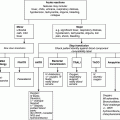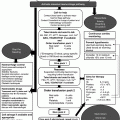Chapter 10 Jerrold H. Levy1 and Anne M. Winkler2,3,4 1 Department of Anesthesiology and Critical Care, Duke University School of Medicine, Durham, NC, USA 2 Department of Pathology and Laboratory Medicine, Emory University School of Medicine, Atlanta, GA, USA 3 Grady Health System Transfusion Service, Atlanta, GA, USA 4 Emory Special Coagulation Laboratory, Atlanta, GA, USA Heparin-induced thrombocytopenia (HIT) is an immune-mediated coagulopathy that can occur in critically ill patients following heparin exposure that is associated with thrombotic complications. HIT is a clinicopathologic diagnosis that requires stopping heparin and initiating alternative anticoagulation therapy if a thrombotic event occurs or for thromboembolic prophylaxis [1]. This chapter will discuss the pathophysiology, diagnosis, treatment and alternative anticoagulation strategies for HIT in the intensive care unit (ICU). The prothrombotic events occurring with HIT are caused by antibodies that develop to a complex of heparin and platelet factor 4 (PF4), a basic protein stored in the alpha granules of platelets. Following platelet activation, especially after surgery, immunoglobulin G (IgG) antibodies form against the complexes of heparin and PF4 in certain susceptible individuals. There is a stoichiometric ratio at which this complex formation occurs since excess amounts of either heparin or PF4 may not allow the complex to develop. Once the antibodies are formed, they activate platelets through their Fc domain and FcγIIa receptors. The activated platelets generate microparticles and activate monocytes and endothelial cells, which express tissue factor, all resulting in a procoagulant state. Although 7–50% of heparin-treated patients form low titres of heparin–PF4 antibodies, clinical HIT is estimated to occur in approximately 1–5% of patients receiving unfractionated heparin and less than 1% of patients receiving low-molecular-weight heparin [2, 3]. In the ICU setting with complex critically ill patients, the incidences may be higher. The incidence in cardiac transplant and neurosurgical patients is reported to be 11% and 15%, respectively [1]. In this context, it is important to bear in mind that positivity for HIT antibodies, by itself, does not translate into clinical HIT. The iceberg model proposed by Warkentin illustrates this point, wherein only few patients with antibody positivity will have clinical HIT, and of these, only few will develop thrombosis. Post-operative cardiac surgery patients are at an increased risk of antibody development, in part due to platelet activation that occurs following surgery and cardiopulmonary bypass (CPB) and the higher doses of heparin administered. HIT antibodies are usually cleared in approximately 3 months [4]. The presence and the level of the antibodies, irrespective of thrombocytopenia, are associated with increased adverse events. HIT increases the odds of thrombosis (odds ratio, 37) with an overall thrombotic risk of 38–76%. Thrombosis appears coincident with, or slightly before, the decline in platelet count [5]. The diagnosis of HIT in the ICU is often difficult due to competing causes of thrombocytopenia including post-operative dilutional changes, sepsis, disseminated intravascular coagulation, intra-aortic balloon pump (IABP) with mechanical destruction, extracorporeal life support (ECLS) or other drug-induced causes of thrombocytopenia (see Chapter 3) [6]. In cardiac patients, glycoprotein IIb–IIIa inhibitors are important causes of drug-induced thrombocytopenia, and thienopyridines have been associated with rare cases of thrombotic thrombocytopenic purpura (TTP). An important cause of thrombocytopenia in the ICU is volume resuscitation after haemorrhagic shock and CPB where a 40–60% decrease in platelet count occurs. HIT after CPB often has a biphasic pattern that decreases after CPB-related thrombocytopenia corrects or a persistently low/decreasing platelet count greater than 4 days post-operatively. HIT can manifest acutely within minutes–hours of heparin exposure (rapid-onset HIT) associated with hypotension or shock caused by pre-existing antibodies due to prior exposure, manifesting as anaphylaxis, and include hypotension, pulmonary hypertension and/or tachycardia 2–30 min after intravenous administration [1]. HIT can also occur days to weeks after exposure (delayed-onset HIT) in patients presenting with thrombosis.
Heparin-Induced Thrombocytopenia
Introduction
Pathogenesis/frequency
Thrombocytopenia in the ICU
Laboratory testing
Stay updated, free articles. Join our Telegram channel

Full access? Get Clinical Tree






